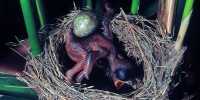On March 3, 1876, it poured a material that looked disturbingly like flesh in Olympian Springs, Kentucky. The meat “covered a strip of ground approximately one hundred yards long and fifty broads” near Allen Crouch’s house, according to the New York Times. Mrs. Crouch, who was making soap in the yard at the time, reported it fell like snow, with the exception that she thought it looked like meat. The next day, a man named Harrison Gill went to the scene and saw pieces of what seemed to be fresh flesh clinging to the fences and strewn across the ground, some of which were as large as two inches square.
You may have noticed that this appears to be quite improbable at this stage. For example, there are several phrases for meteorological occurrences in our language, but none of them mention “totally beefing it down out there.” The New York Times, on the other hand, concluded that the witnesses to the event were unquestionably credible. They were, it turned out, hungry boys as well. Two “gentlemen” – a debatable phrase considering that they were going to consume some floor beef – sampled the meat and declared it to be “either mutton or venison.”
If you had to speculate what caused the incident, stating that it was caused by weather – possibly a minor tornado – wouldn’t be a terrible idea. The sky, on the other hand, were believed to be clear on this particular day. So, what went wrong? The meat was sent out for a more thorough examination than scooping it up off the floor, munching on it, and saying that it “tastes a touch muttony.” Dr. A. Mead Edwards examined the material and proclaimed it to be either horse lung tissue or human newborn flesh – statements that would undoubtedly make certain gentlemen in Kentucky nauseous.
Others examined the sample and determined that, while they couldn’t say for sure what it was, it appeared to contain lung tissue, cartilage, and muscle tissue. “The mystery has been solved.” But wait, you say, the mystery here isn’t whether the meat was beef or not, but how it got to fall from the sky on a bright Kentucky day. Later that year, Dr. L. D Kastenbine backed up a plausible explanation offered by a local farmer in Louisville Medical News, which would only add to the nausea of anyone who had eaten some excellent fence beef.
He stated, “The only reasonable explanation accounting of this aberrant shower appears to me to be that indicated by the elderly Ohio farmer,” adding that the samples he examined looked to be mutton (thank goodness) rather than human infants. “The disgorgement of some vultures that were flying above the site, and the particles were distributed across the ground by the prevailing wind at the time.” “Only this idea can explain the variety of tissue observed – muscular, connective, fatty, structureless, and so on.”
Vultures are notorious for scavenging meat and devouring it when the opportunity arises. Unfortunately, their wings aren’t strong enough to support all much weight. When they are upset, like as when their flight is disrupted by another bird or a predator on the ground, they are more likely to vomit to lessen their weight. This happened on March 3, 1876, according to the most plausible scenario. While disgusting, in the vultures’ defense, you are under no duty to collect the vomit, cook it up, eat it, and then guess on what meat the vomit tastes like.
















